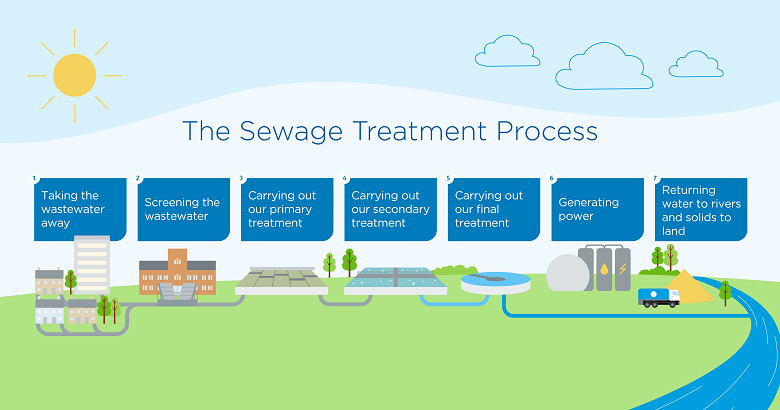Secret Challenges in Urban Waste Water Treatment Approaches
Secret Challenges in Urban Waste Water Treatment Approaches
Blog Article
Strategic Approaches to Boost Drainage Treatment Effectiveness and Decrease Ecological Influence
In the world of waste water treatment, the pursuit for enhanced efficiency and lowered ecological influence is a perpetual difficulty that requires strategic remedies. The combination of sophisticated treatment technologies, energy-efficient processes, source recovery approaches, boosted nutrient removal strategies, and wise surveillance and control systems stands for a complex framework for resolving these pressing issues.
Advanced Therapy Technologies
Sophisticated membrane filtration systems have actually changed advanced wastewater treatment processes, dramatically enhancing the removal of pollutants. These cutting-edge systems work by compeling water via a semi-permeable membrane layer, effectively dividing impurities from the water stream. The membrane layer's microscopic pores catch pollutants such as bacteria, infections, and put on hold solids, allowing only purified water to travel through. This innovation has verified to be extremely efficient in eliminating a wide variety of contaminants, consisting of pharmaceuticals, hefty steels, and organic compounds, which are commonly testing to remove with standard treatment methods.
In addition, membrane filtration systems use numerous advantages over conventional treatment techniques. Furthermore, these systems are extremely versatile and can be easily integrated right into existing therapy plants or utilized as standalone units for decentralized applications.
Energy-Efficient Procedures
The combination of energy-efficient processes in wastewater treatment systems is essential for maximizing source usage and decreasing functional prices. By implementing energy-efficient modern technologies, treatment plants can considerably reduce their carbon impact and total ecological impact. One key approach to boosting energy efficiency in wastewater treatment is the use of innovative aeration systems, such as great bubble diffusers or surface aerators, which can improve oxygen transfer effectiveness and minimize power consumption. In addition, integrating energy healing systems, like anaerobic digestion for biogas production or utilizing excess warm for thermal processes, can assist balance out energy needs and promote sustainability.
In addition, enhancing procedure control and automation via making use of sophisticated sensors and keeping an eye on systems can improve general power performance by readjusting procedures in real-time based upon actual need and problems. Implementing energy audits and consistently monitoring power performance indications are essential practices to recognize areas for improvement and track energy-saving campaigns successfully. In general, the fostering of energy-efficient procedures in wastewater treatment not just profits the atmosphere but additionally contributes to lasting price financial savings and functional sustainability.
Source Recuperation Strategies
With a concentrate on optimizing resource use and sustainability in wastewater therapy systems, the implementation of source recovery strategies becomes a critical element in enhancing functional effectiveness. Source healing techniques in wastewater therapy involve the identification and removal of beneficial resources from the waste stream, therefore turning what was as soon as considered waste into a valuable asset. By applying resource recuperation methods such as nutrient elimination and healing, power generation from organic matter, and the production of multiple-use water, wastewater therapy plants can minimize ecological effect while taking full advantage of effectiveness.

Enhanced Nutrient Removal Strategies
Executing sophisticated nutrient removal strategies is essential for optimizing the effectiveness of wastewater therapy systems. Enhanced nutrient removal plays a crucial duty in reducing the ecological influence of cured effluent released right into water bodies. Among the vital strategies used for improved nutrient removal is the procedure of organic nutrient removal (BNR), which entails the elimination of nitrogen and phosphorus through organic processes. This can be accomplished with the use of specialized microbes that can transform nitrogen compounds right into inert nitrogen gas through denitrification, and accumulate phosphorus within their cells through a procedure called improved organic phosphorus elimination (EBPR)

In addition click this to BNR, advanced therapy techniques such as membrane bioreactors (MBRs) and created marshes can also be used to improve nutrient removal effectiveness. By including these sophisticated nutrient elimination strategies right into wastewater treatment towns, industries and systems can effectively decrease nutrient contamination and secure the environment.
Smart Monitoring and Control Equipment
Making use of innovative technology, the assimilation of wise surveillance and control systems reinvents the operational effectiveness of wastewater therapy facilities. These systems integrate advanced sensors and information analytics to continually keep an eye on key criteria such as pH levels, turbidity, dissolved oxygen, and circulation prices in real-time. By collecting and assessing this information, operators can acquire important understandings right into the performance of the therapy procedures, allowing proactive adjustments to enhance therapy performance.
Smart surveillance and control systems additionally support remote monitoring abilities, enabling operators to gain access to real-time information and control functions from off-site places. This remote availability boosts operational versatility and responsiveness, making it possible for swift treatments blog here in case of system breakdowns or variations in influent high quality. Moreover, the anticipating upkeep capacities of these systems aid avoid tools failures and minimize downtime, eventually improving the total dependability of wastewater treatment operations (Waste Water Treatment).
Verdict
In conclusion, calculated approaches such as innovative therapy technologies, energy-efficient processes, resource recuperation techniques, improved nutrient removal methods, and clever surveillance and control systems play a crucial role in enhancing wastewater treatment efficiency and minimizing environmental impact. By implementing these techniques, wastewater therapy plants can boost their total efficiency, lower energy consumption, recoup useful resources, and make sure conformity with environmental policies. These methods are crucial for reliable and sustainable wastewater monitoring practices.

In conclusion, strategic approaches such as advanced my website therapy technologies, energy-efficient procedures, source recovery methods, enhanced nutrient removal strategies, and wise tracking and control systems play a critical role in enhancing wastewater therapy performance and minimizing ecological impact.
Report this page